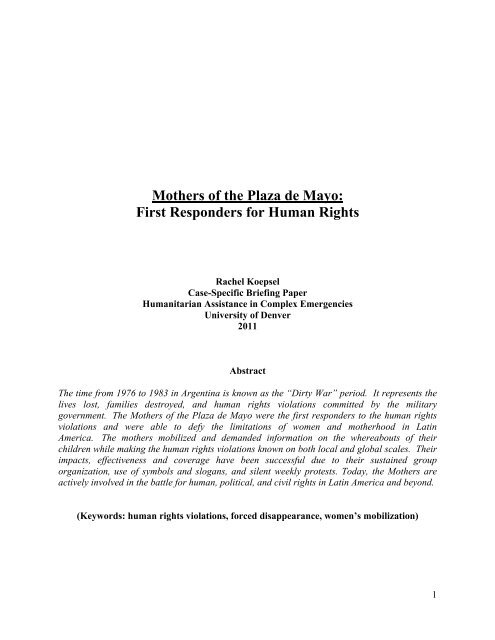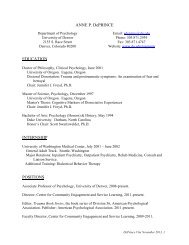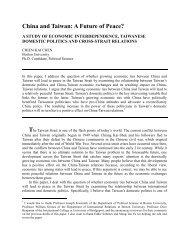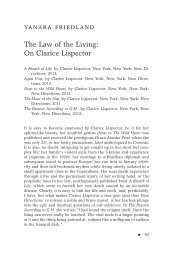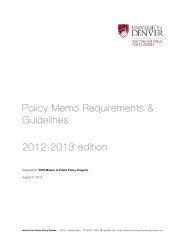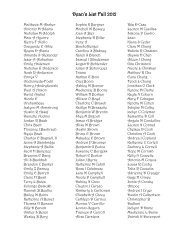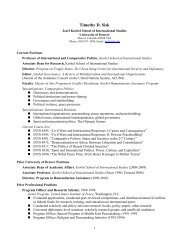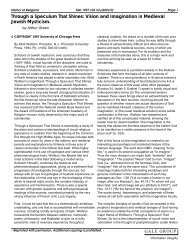Mothers of the Plaza de Mayo: First Responders for Human Rights
Mothers of the Plaza de Mayo: First Responders for Human Rights
Mothers of the Plaza de Mayo: First Responders for Human Rights
You also want an ePaper? Increase the reach of your titles
YUMPU automatically turns print PDFs into web optimized ePapers that Google loves.
<strong>Mo<strong>the</strong>rs</strong> <strong>of</strong> <strong>the</strong> <strong>Plaza</strong> <strong>de</strong> <strong>Mayo</strong>:<br />
<strong>First</strong> Respon<strong>de</strong>rs <strong>for</strong> <strong>Human</strong> <strong>Rights</strong><br />
Rachel Koepsel<br />
Case-Specific Briefing Paper<br />
<strong>Human</strong>itarian Assistance in Complex Emergencies<br />
University <strong>of</strong> Denver<br />
2011<br />
Abstract<br />
The time from 1976 to 1983 in Argentina is known as <strong>the</strong> “Dirty War” period. It represents <strong>the</strong><br />
lives lost, families <strong>de</strong>stroyed, and human rights violations committed by <strong>the</strong> military<br />
government. The <strong>Mo<strong>the</strong>rs</strong> <strong>of</strong> <strong>the</strong> <strong>Plaza</strong> <strong>de</strong> <strong>Mayo</strong> were <strong>the</strong> first respon<strong>de</strong>rs to <strong>the</strong> human rights<br />
violations and were able to <strong>de</strong>fy <strong>the</strong> limitations <strong>of</strong> women and mo<strong>the</strong>rhood in Latin<br />
America. The mo<strong>the</strong>rs mobilized and <strong>de</strong>man<strong>de</strong>d in<strong>for</strong>mation on <strong>the</strong> whereabouts <strong>of</strong> <strong>the</strong>ir<br />
children while making <strong>the</strong> human rights violations known on both local and global scales. Their<br />
impacts, effectiveness and coverage have been successful due to <strong>the</strong>ir sustained group<br />
organization, use <strong>of</strong> symbols and slogans, and silent weekly protests. Today, <strong>the</strong> <strong>Mo<strong>the</strong>rs</strong> are<br />
actively involved in <strong>the</strong> battle <strong>for</strong> human, political, and civil rights in Latin America and beyond.<br />
(Keywords: human rights violations, <strong>for</strong>ced disappearance, women’s mobilization)<br />
1
Background:<br />
<strong>Human</strong> rights activists, victim’s families and writers refer to <strong>the</strong> period <strong>of</strong> time between<br />
1976 and 1983 in Argentina as <strong>the</strong> “Dirty War” period, representing <strong>the</strong> lives lost, families<br />
<strong>de</strong>stroyed, and human rights violations committed by <strong>the</strong> military government. This term was,<br />
and is, used to <strong>de</strong>scribe <strong>the</strong> undisclosed civil war taking place between <strong>the</strong> left wing supporters<br />
<strong>of</strong> re<strong>for</strong>m and <strong>the</strong> Argentine Army backed by <strong>the</strong> right wing. The ultimate goal <strong>of</strong> <strong>the</strong> Dirty War<br />
was to “compel all people, by <strong>for</strong>ce and persuasion, to uphold a conservative national i<strong>de</strong>ntity<br />
and patriarchal i<strong>de</strong>ology.” 1 Citizens in opposition to <strong>the</strong> military coup were consi<strong>de</strong>red to be<br />
conspirators <strong>of</strong> <strong>the</strong> government, dissi<strong>de</strong>nts and guilty <strong>of</strong> wanting to remove <strong>the</strong> country <strong>of</strong> its<br />
“harmony and unity.” Junta lea<strong>de</strong>rs <strong>of</strong> <strong>the</strong> army instilled antinationalist sentiments, communist<br />
i<strong>de</strong>ologies and chaos in <strong>the</strong> general population in or<strong>de</strong>r to preserve <strong>the</strong> Argentine State.<br />
Overview:<br />
During <strong>the</strong> period <strong>of</strong> <strong>the</strong> Dirty War, anyone who verbally expressed <strong>the</strong>ir opposition to<br />
<strong>the</strong> military government or partook in related group discussions, violated <strong>the</strong> laws <strong>of</strong> <strong>the</strong> coup, or<br />
even casually spoke/criticized <strong>the</strong> coup vanished without a trace. It is believed that <strong>the</strong> Junta<br />
lea<strong>de</strong>rs, generals within <strong>the</strong> military government, were responsible <strong>for</strong> <strong>the</strong> disappearance <strong>of</strong><br />
thousands <strong>of</strong> citizens <strong>of</strong> Argentina.<br />
• The estimates <strong>of</strong> disappeared persons during this time range from 30,000 to more than 45,000<br />
and do not take into account <strong>the</strong> cases where entire families were kidnapped, leaving no one<br />
behind to report <strong>the</strong>m as missing. 2<br />
1 Cynthia Bejarano, “Las Super Madres <strong>de</strong> Latino America: Trans<strong>for</strong>ming Mo<strong>the</strong>rhood by Challenging Violence in<br />
Mexico, Argentina and El Salvador,” Frontiers: A Journal <strong>of</strong> Women Studies 23(1)(2006): 146<br />
2 Kathy Domenici and Karen Foss, “Haunting Argentina: Synedoche in <strong>the</strong> Protests <strong>of</strong> <strong>the</strong> <strong>Mo<strong>the</strong>rs</strong> <strong>of</strong> <strong>the</strong> <strong>Plaza</strong> <strong>de</strong><br />
<strong>Mayo</strong>,” Quarterly Journal <strong>of</strong> Speech 87(3)(2001): 237<br />
2
• The vast majority <strong>of</strong> those who disappeared were young, generally between <strong>the</strong> ages <strong>of</strong> 20<br />
and 25, and were usually educated, politically aware and i<strong>de</strong>alistic. 3<br />
In response to <strong>the</strong> disappearances, mo<strong>the</strong>rs in Buenos Aires were able to mobilize toge<strong>the</strong>r<br />
<strong>de</strong>spite <strong>the</strong>ir diverse backgrounds (geographic origins, economic and social classes, religion,<br />
political i<strong>de</strong>ology, and gen<strong>de</strong>r orientation) to <strong>de</strong>mand <strong>the</strong> truth about <strong>the</strong>ir children. In <strong>the</strong> case<br />
<strong>of</strong> Buenos Aires, <strong>the</strong> disappearances were a unifying catalyst <strong>for</strong> change. Toge<strong>the</strong>r, <strong>the</strong> mo<strong>the</strong>rs<br />
<strong>of</strong> <strong>the</strong> disappeared created <strong>the</strong> organization, Asociación Madres <strong>de</strong> <strong>Plaza</strong> <strong>de</strong> <strong>Mayo</strong> (Association<br />
<strong>of</strong> <strong>the</strong> <strong>Mo<strong>the</strong>rs</strong> <strong>of</strong> <strong>the</strong> <strong>Plaza</strong> <strong>de</strong> <strong>Mayo</strong>) in 1977 and began to engage in peaceful protests to <strong>for</strong>ce<br />
<strong>the</strong> government to release in<strong>for</strong>mation about <strong>the</strong>ir missing children. 4<br />
• Every Thursday at 3:30 pm, The Madres continue <strong>the</strong>ir peaceful protests, which inclu<strong>de</strong><br />
marching around <strong>the</strong> <strong>Plaza</strong> <strong>de</strong> <strong>Mayo</strong>, located directly in front <strong>of</strong> <strong>the</strong> Presi<strong>de</strong>nt’s resi<strong>de</strong>nce (<strong>the</strong><br />
Casa Rosada or Pink House), wearing <strong>the</strong>ir tra<strong>de</strong>mark white headscarves and carrying<br />
photographs <strong>of</strong> <strong>the</strong>ir children.<br />
• The Madres are still <strong>de</strong>dicated to <strong>de</strong>nying <strong>the</strong> government an excuse to <strong>for</strong>get and move on<br />
without acknowledging its complicity and failure to bring <strong>the</strong> guilty to justice, but have also<br />
evolved to inclu<strong>de</strong> exposing <strong>the</strong> abuses <strong>of</strong> o<strong>the</strong>r repressive regimes, working <strong>for</strong> human rights<br />
generally, and responding to injustices elsewhere. 5<br />
• Since <strong>the</strong> mobilization in 1977, <strong>the</strong> <strong>Mo<strong>the</strong>rs</strong> <strong>of</strong> <strong>the</strong> <strong>Plaza</strong> <strong>de</strong> <strong>Mayo</strong> has split into two groups,<br />
<strong>the</strong> original organization and Asociación Madres, Linea Fundadora, n.d. (Founding Line).<br />
3<br />
Malin, “Mo<strong>the</strong>r Who Won’t Disappear,” <strong>Human</strong> <strong>Rights</strong> Quarterly 16(1)(1993): 195<br />
4<br />
Domenici and Fross, “Haunting Argentina,” 237<br />
5<br />
Sally Webb Thornton, “Greif Trans<strong>for</strong>med: The <strong>Mo<strong>the</strong>rs</strong> <strong>of</strong> <strong>the</strong> <strong>Plaza</strong> <strong>de</strong> <strong>Mayo</strong>,” Omega Journal 41(4)(2000): 286-<br />
287<br />
3
• The Founding Line is non-hierarchical and attempts to work with <strong>the</strong> government to find<br />
answers. It is interested in discovering <strong>the</strong> particular cause <strong>of</strong> <strong>de</strong>ath <strong>for</strong> each individual killed<br />
during <strong>the</strong> Dirty War.<br />
• The original organization is more hierarchical and strives to make sure <strong>of</strong>fen<strong>de</strong>rs are<br />
punished while preserving <strong>the</strong> cultural memory <strong>of</strong> <strong>the</strong> Dirty War. It is committed to <strong>the</strong><br />
struggle <strong>for</strong> human rights. Some members still believe <strong>the</strong>ir children are missing and not<br />
<strong>de</strong>ad. 6<br />
Impacts:<br />
The traditional roles and responsibilities <strong>of</strong> women in Argentina were strictly confined<br />
within <strong>the</strong> home and workplace; women did not use <strong>the</strong>ir status as mo<strong>the</strong>rs <strong>for</strong> anything o<strong>the</strong>r<br />
than <strong>the</strong> proper upbringing <strong>of</strong> <strong>the</strong>ir children. The <strong>Mo<strong>the</strong>rs</strong> <strong>of</strong> <strong>the</strong> <strong>Plaza</strong> <strong>de</strong> <strong>Mayo</strong> were able to<br />
<strong>de</strong>fy gen<strong>de</strong>r roles and collectively trans<strong>for</strong>m empowerment from mo<strong>the</strong>rs and housewives to <strong>the</strong><br />
public sphere <strong>of</strong> mo<strong>the</strong>rist activism. 7 The mo<strong>the</strong>rs claim <strong>the</strong>ir protests are groun<strong>de</strong>d in <strong>the</strong><br />
natural processes <strong>of</strong> family and mo<strong>the</strong>rhood that were disrupted by <strong>the</strong> human rights violations<br />
committed by <strong>the</strong> military government. Fur<strong>the</strong>rmore, <strong>the</strong>y use <strong>the</strong> concept <strong>of</strong> Marianismo, <strong>the</strong><br />
cult <strong>of</strong> feminine spiritual superiority and self-sacrifice that makes an i<strong>de</strong>al mo<strong>the</strong>r and wife in <strong>the</strong><br />
Latin American tradition. This unique combination <strong>of</strong> cultural glorification and respect tied to<br />
mo<strong>the</strong>rhood makes <strong>the</strong> <strong>Mo<strong>the</strong>rs</strong> somewhat “untouchable,” and initially allowed <strong>the</strong>m to<br />
<strong>de</strong>monstrate during a time when all protests were prohibited. 8 They were able to use<br />
“mo<strong>the</strong>rhood” as a shield. This had pr<strong>of</strong>ound impacts on many mo<strong>the</strong>rs in Argentine society.<br />
6<br />
Domenici and Fross, “Haunting Argentina,” 238-239<br />
7<br />
Bejarano, “Las Super Madres,” 126<br />
8<br />
Domenici and Fross, “Haunting Argentina,” 240<br />
4
• The <strong>Mo<strong>the</strong>rs</strong> broke down barriers within both public and private realms and released<br />
mo<strong>the</strong>rs, generally, from lives that were “naturally <strong>de</strong>termined” so as to enter into lives that<br />
were “socially <strong>de</strong>termined,” allowing <strong>the</strong>m to be subjects <strong>for</strong> – not merely <strong>the</strong> objects <strong>of</strong> –<br />
political action.<br />
• <strong>Mo<strong>the</strong>rs</strong> became public figures; <strong>the</strong>y showed <strong>the</strong>mselves as ready to accept all risk inherited<br />
in such rebellious activities.<br />
The occurrence <strong>of</strong> disappearances was not unique to Argentina. Since 1964 <strong>the</strong>re have been<br />
over 90,000 governmental disappearances and killings in Latin America. 9 After seeing how<br />
mo<strong>the</strong>rs in Argentina could make a difference when mobilizing toge<strong>the</strong>r, women in o<strong>the</strong>r<br />
countries began to utilize <strong>the</strong>ir roles as mo<strong>the</strong>rs as <strong>for</strong>ms <strong>of</strong> resistance – and were successful.<br />
• O<strong>the</strong>r mo<strong>the</strong>r-<strong>for</strong>med human rights movements took place in Chile (1973), as well as Brazil,<br />
Uruguay, Guatemala and Honduras (late 1970s-early 1980s), and more recently in Sri Lanka<br />
(1990). 10<br />
Coverage:<br />
The <strong>Mo<strong>the</strong>rs</strong> were able to utilize an effective set <strong>of</strong> symbols in or<strong>de</strong>r to manage <strong>the</strong>ir<br />
personal trauma and grief while creating awareness <strong>for</strong> <strong>the</strong>ir disappeared children. When <strong>the</strong><br />
organization was first <strong>for</strong>med, <strong>the</strong> <strong>Mo<strong>the</strong>rs</strong> wore white diaper kerchiefs on <strong>the</strong>ir heads to easily<br />
i<strong>de</strong>ntify who were members <strong>of</strong> <strong>the</strong> group. As <strong>the</strong> organization progressed, <strong>the</strong> diapers became<br />
white handkerchiefs with <strong>the</strong> names and dates <strong>of</strong> <strong>the</strong> wearers’ disappeared children on <strong>the</strong> back.<br />
The handkerchiefs represent that <strong>the</strong> disappeared children are never <strong>for</strong>gotten. They also help<br />
raise awareness by initiating conversations with curious citizens who are interested in <strong>the</strong><br />
significance <strong>of</strong> <strong>the</strong> handkerchiefs and become in<strong>for</strong>med <strong>of</strong> <strong>the</strong> government’s human rights<br />
9 Malin, “Mo<strong>the</strong>r Who Won’t Disappear,” 194.<br />
10 Malin, “Mo<strong>the</strong>r Who Won’t Disappear,” 200.<br />
5
violations. Early on, this practice helped recruit new members to <strong>the</strong> organization, as o<strong>the</strong>r<br />
mo<strong>the</strong>rs who also had missing family members became aware <strong>of</strong> <strong>the</strong> <strong>Mo<strong>the</strong>rs</strong> <strong>of</strong> <strong>the</strong> <strong>Plaza</strong> <strong>de</strong><br />
<strong>Mayo</strong>. The diaper and present-day handkerchiefs symbolize <strong>the</strong> most basic <strong>of</strong> human bonds and<br />
a missing generation. 11<br />
In addition to <strong>the</strong> handkerchiefs, <strong>the</strong> <strong>Mo<strong>the</strong>rs</strong> came up with <strong>the</strong> slogan, “Apracion con<br />
Vida” (Bring Them Back Alive) to represent <strong>the</strong>ir organization. The <strong>Mo<strong>the</strong>rs</strong> believe <strong>the</strong> slogan<br />
is a way <strong>of</strong> saying “no one has taken responsibility <strong>for</strong> <strong>the</strong>ir <strong>de</strong>aths because no one has said who<br />
killed <strong>the</strong>m, who gave <strong>the</strong> or<strong>de</strong>r.” They argue that “if <strong>the</strong>ir children were taken without being<br />
charged with crimes, those who killed <strong>the</strong>m should be found and brought to justice:<br />
[paradoxically] to admit and acknowledge <strong>the</strong>ir children’s <strong>de</strong>ath excuses those responsible. Thus<br />
many <strong>Mo<strong>the</strong>rs</strong> refuse to talk about <strong>the</strong>ir children as <strong>de</strong>ad.” 12 This slogan is embroi<strong>de</strong>red on <strong>the</strong><br />
backs <strong>of</strong> <strong>the</strong>ir handkerchiefs and calls attention to <strong>the</strong> disruption <strong>of</strong> <strong>the</strong> natural life cycle.<br />
Originally <strong>the</strong> <strong>Mo<strong>the</strong>rs</strong> <strong>de</strong>ci<strong>de</strong>d to walk <strong>de</strong>spite <strong>the</strong> clear and obvious violation <strong>of</strong> <strong>the</strong><br />
military government’s laws against <strong>de</strong>monstrations. They chose <strong>the</strong> <strong>Plaza</strong> <strong>de</strong> <strong>Mayo</strong> where <strong>the</strong>y<br />
would be unprotected in an enormous place in or<strong>de</strong>r show that <strong>the</strong>y were willing to risk<br />
everything to learn what happened to <strong>the</strong>ir family members. Today, <strong>the</strong> <strong>Plaza</strong> <strong>de</strong> <strong>Mayo</strong> is tacitly<br />
acknowledged as belonging to <strong>the</strong> mo<strong>the</strong>rs. 13 The <strong>Mo<strong>the</strong>rs</strong> trans<strong>for</strong>med plazas across Argentina<br />
into key places where women can meet, <strong>de</strong>velop friendships, share feelings, <strong>de</strong>sign strategies <strong>for</strong><br />
future mobilization, and create networks visible to <strong>the</strong> general public. 14<br />
11 Domenici and Foss, “Haunting Argentina,” 243-245.<br />
12 Domenici and Foss “Haunting Argentina,” 245<br />
13 Domenici and Foss, “Haunting Argentina,” 247.<br />
14 Fernando J. Bosco, “The Madres <strong>de</strong> <strong>Plaza</strong> <strong>de</strong> <strong>Mayo</strong> and Three Deca<strong>de</strong>s <strong>of</strong> <strong>Human</strong> <strong>Rights</strong>’ Activism:<br />
Embed<strong>de</strong>dness, Emotions, and Social Movements. Association <strong>of</strong> American Geographers 96(2)(2006): 15.<br />
6
• <strong>Plaza</strong>s have been <strong>the</strong> key to sustainability <strong>of</strong> <strong>the</strong> movement over time because <strong>the</strong>y became<br />
meeting areas and have contributed in helping <strong>the</strong> <strong>Mo<strong>the</strong>rs</strong> mobilize toge<strong>the</strong>r over <strong>the</strong>ir<br />
feelings <strong>for</strong> <strong>the</strong>ir missing children.<br />
• When <strong>Mo<strong>the</strong>rs</strong> travel or move abroad, many <strong>of</strong> <strong>the</strong>m will select a plaza in <strong>the</strong>ir new<br />
<strong>de</strong>stination, adjust <strong>for</strong> <strong>the</strong> time difference and walk in <strong>the</strong> plaza (even if <strong>the</strong>y are alone) “in<br />
parallel time,” to feel connected to <strong>the</strong>ir fellow <strong>Mo<strong>the</strong>rs</strong> who are doing <strong>the</strong> same back in<br />
Buenos Aires. 15<br />
• The <strong>Mo<strong>the</strong>rs</strong> have been able to maintain a feeling <strong>of</strong> proximity <strong>de</strong>spite <strong>the</strong>ir physical distance<br />
and in spite <strong>of</strong> <strong>the</strong>ir large territorial network by recreating spaces <strong>of</strong> emotional intensity at <strong>the</strong><br />
plazas in or<strong>de</strong>r to rein<strong>for</strong>ce <strong>the</strong>ir collective ga<strong>the</strong>rings, which helps replicate <strong>the</strong> movement<br />
across Argentina and abroad. 16<br />
Some mo<strong>the</strong>rs <strong>de</strong>velop such strong connections with <strong>the</strong> <strong>Plaza</strong> <strong>de</strong> <strong>Mayo</strong> that <strong>the</strong>y request <strong>the</strong>ir<br />
remains to be “interred” in <strong>the</strong> <strong>Plaza</strong> with <strong>the</strong>ir hermanas (sisters), placed around <strong>the</strong> monument<br />
in <strong>the</strong> center as a way to keep walking every Thursday and to not leave <strong>the</strong>ir fellow <strong>Mo<strong>the</strong>rs</strong><br />
alone. 17<br />
The <strong>Plaza</strong> symbolizes more than just a meeting place and a sustainable tool <strong>of</strong> <strong>the</strong><br />
<strong>Mo<strong>the</strong>rs</strong>. It fur<strong>the</strong>r represents <strong>the</strong> “walking in circles” <strong>the</strong> <strong>Mo<strong>the</strong>rs</strong> did from government <strong>of</strong>fices,<br />
police <strong>of</strong>fices, and army facilities, to prisons seeking answers about <strong>the</strong>ir children. They would<br />
wait <strong>for</strong> hours without water, food or <strong>the</strong> use <strong>of</strong> sanitation facilities only to be told to return<br />
ano<strong>the</strong>r day. The circle represents <strong>the</strong>ir never-ending activities and <strong>de</strong>dication to <strong>the</strong> return <strong>of</strong><br />
<strong>the</strong>ir children. 18<br />
15 Bosco, “The Madres <strong>de</strong> <strong>Plaza</strong> <strong>de</strong> <strong>Mayo</strong>,” 17.<br />
16 Bosco, “The Madres <strong>de</strong> <strong>Plaza</strong> <strong>de</strong> <strong>Mayo</strong>,” 17.<br />
17 Bosco, “The Madres <strong>de</strong> <strong>Plaza</strong> <strong>de</strong> <strong>Mayo</strong>,” 15.<br />
18 Domenici and Foss, “Haunting Argentina,” 248.<br />
7
Silhouettes and photographs were also utilized by <strong>the</strong> <strong>Mo<strong>the</strong>rs</strong> to spread coverage and<br />
awareness <strong>of</strong> <strong>the</strong> disappeared. Once a year, <strong>for</strong> 24 hours, <strong>the</strong> <strong>Mo<strong>the</strong>rs</strong> cut out and paint<br />
silhouettes and glue <strong>the</strong>m to buildings, walls and trees around <strong>the</strong> cities. The empty silhouettes,<br />
some 30,000 <strong>of</strong> <strong>the</strong>m, appear around Buenos Aires with <strong>the</strong> names and dates <strong>of</strong> missing people. 19<br />
Such an act reminds <strong>the</strong> Argentine society as well as <strong>the</strong> government that <strong>Mo<strong>the</strong>rs</strong> are still<br />
fiercely fighting against corruption and <strong>the</strong> accused torturers and assassins. The silhouettes do<br />
not “fill <strong>the</strong> emptiness, <strong>the</strong>y only give it shape. And quantity.” 20 For a day, <strong>the</strong> disappeared<br />
seemingly are more alive than <strong>the</strong> rest <strong>of</strong> <strong>the</strong> population.<br />
• Photographs are worn around <strong>the</strong> Mo<strong>the</strong>r’s necks when <strong>the</strong>y march on Thursdays. They<br />
construct a powerful representation <strong>of</strong> <strong>the</strong> disappeared, showing <strong>the</strong> public that <strong>the</strong>y are<br />
present in society through photographs, while at <strong>the</strong> same time absent. 21<br />
• The photographs not only remind society <strong>of</strong> <strong>the</strong> missing but also <strong>of</strong> this question: Could it<br />
happen again? Could it happen to <strong>the</strong>ir family? What kind <strong>of</strong> society are <strong>the</strong>y living in that<br />
not only sanctions but initiates such abuses <strong>of</strong> human rights? 22<br />
• The <strong>Mo<strong>the</strong>rs</strong> were also able to provi<strong>de</strong> coverage by putting <strong>the</strong>ir feelings into words. Many<br />
<strong>Mo<strong>the</strong>rs</strong> found com<strong>for</strong>t in writing poems about <strong>the</strong>ir experiences. Such poems were <strong>the</strong>n<br />
complied into booklets and passed out around <strong>the</strong> city in or<strong>de</strong>r to create additional<br />
awareness. 23<br />
19 Malin, “Mo<strong>the</strong>r’s Who Won’t,” 202<br />
20 Domenici and Foss, “Haunting Argentina,” 249.<br />
21 Domenici and Foss, “Haunting Argentina,” 250.<br />
22 Domenici and Foss, “Haunting Argentina,” 250.<br />
23 Bosco, “The Madres <strong>de</strong> <strong>Plaza</strong> <strong>de</strong> <strong>Mayo</strong>,” 351.<br />
8
Effectiveness:<br />
The <strong>Mo<strong>the</strong>rs</strong> effectively brought mo<strong>the</strong>rhood out <strong>of</strong> <strong>the</strong> domestic closet and showed how<br />
it can also be a social construct. They were able to create a new space <strong>of</strong> representation <strong>for</strong><br />
women in <strong>the</strong> Argentine society. Fur<strong>the</strong>rmore, <strong>the</strong> <strong>Mo<strong>the</strong>rs</strong> were able to overcome <strong>the</strong> challenge<br />
that many social movements face; <strong>the</strong>y have successfully sustained <strong>the</strong>ir organization <strong>for</strong> over 30<br />
years and are still very active today. 24<br />
The <strong>Mo<strong>the</strong>rs</strong> <strong>of</strong> <strong>the</strong> <strong>Plaza</strong> <strong>de</strong> <strong>Mayo</strong> were <strong>the</strong> first to walk in protest to <strong>the</strong> military<br />
government. Since <strong>the</strong>n, o<strong>the</strong>r groups <strong>of</strong> women throughout <strong>the</strong> country began to mobilize or<br />
<strong>for</strong>m <strong>the</strong>ir own mo<strong>the</strong>r’s groups, and have since become chapters <strong>of</strong> <strong>the</strong> organization. The<br />
<strong>Mo<strong>the</strong>rs</strong> have been able to create a sustainable network throughout not only Argentina but<br />
abroad. Members <strong>of</strong> <strong>the</strong> organization are scattered in more than 20 cities across Argentina and<br />
promote awareness and fight <strong>for</strong> <strong>the</strong>ir causes toge<strong>the</strong>r every Thursday (as noted above) at <strong>the</strong><br />
same time as <strong>the</strong>ir sisters in Buenos Aires. Mo<strong>the</strong>r “support groups” are spread out across North<br />
America and Europe.<br />
The <strong>Mo<strong>the</strong>rs</strong> organization is particularly effective in sustaining such networks due to<br />
<strong>the</strong>ir linkage through a common cause, <strong>the</strong> disappearance <strong>of</strong> <strong>the</strong>ir children. They have created a<br />
complex web <strong>of</strong> interactions among individual members and <strong>for</strong>mal organizational structures.<br />
Despite <strong>the</strong>ir separation into <strong>Mo<strong>the</strong>rs</strong> <strong>of</strong> <strong>the</strong> <strong>Plaza</strong> <strong>de</strong> <strong>Mayo</strong> and The Founding-Line, <strong>the</strong><br />
organizations have been able to overcome <strong>the</strong>ir different views to <strong>of</strong>ten work toge<strong>the</strong>r. This is<br />
possible since <strong>the</strong>y first i<strong>de</strong>ntify <strong>the</strong>mselves, collectively, as “<strong>the</strong> mo<strong>the</strong>rs <strong>of</strong> <strong>the</strong> disappeared.” 25<br />
The <strong>Mo<strong>the</strong>rs</strong> <strong>the</strong>re<strong>for</strong>e accomplished <strong>the</strong>ir goal <strong>of</strong> spreading awareness <strong>of</strong> <strong>the</strong> events that<br />
were taking place in <strong>the</strong> country and <strong>of</strong> actively working <strong>for</strong> human rights within <strong>the</strong>ir country<br />
24 Bosco, “The Madres <strong>de</strong> <strong>Plaza</strong> <strong>de</strong> <strong>Mayo</strong>,” 351.<br />
25 Bosco, “The Madres <strong>de</strong> <strong>Plaza</strong> <strong>de</strong> <strong>Mayo</strong>,” 344.<br />
9
and with o<strong>the</strong>r human rights organizations. Amnesty International came to publicize much <strong>of</strong> <strong>the</strong><br />
in<strong>for</strong>mation it received. The Ne<strong>the</strong>rlands and Canada became early supporters <strong>of</strong> <strong>the</strong> <strong>Mo<strong>the</strong>rs</strong>.<br />
After a Swedish-Argentine woman was disappeared by <strong>the</strong> coup, Swe<strong>de</strong>n became one <strong>of</strong> <strong>the</strong><br />
Mo<strong>the</strong>r’s biggest and strongest supporters abroad. Presi<strong>de</strong>nt Jimmy Carter, after becoming<br />
aware <strong>of</strong> <strong>the</strong> human rights violations in Argentina through <strong>the</strong> <strong>Mo<strong>the</strong>rs</strong>, had <strong>the</strong> United States<br />
government investigate reports from <strong>the</strong> country. He ultimately ma<strong>de</strong> <strong>the</strong> <strong>de</strong>cision to cut <strong>for</strong>eign<br />
aid to Argentina. The <strong>Mo<strong>the</strong>rs</strong> received fur<strong>the</strong>r international support from Spain and Western<br />
European countries and were able to go abroad to share <strong>the</strong>ir stories and experiences. While in<br />
Italy, <strong>the</strong> <strong>Mo<strong>the</strong>rs</strong> met with Presi<strong>de</strong>nt Sandro Pertini, who became a life-long supporter <strong>of</strong> <strong>the</strong>ir<br />
cause – and a friend. 26 The <strong>Mo<strong>the</strong>rs</strong> also have been internationally recognized <strong>for</strong> <strong>the</strong>ir human<br />
rights struggles by world lea<strong>de</strong>rs and have addressed <strong>the</strong> United Nations. 27<br />
• The Mo<strong>the</strong>r’s activism has received <strong>the</strong> attention <strong>of</strong> many scholars such as Navarro (1989),<br />
Jelin (1990), Bouvard (1994), Taylor (1997), Eckstein (1989), Escobar and Alvarez (1992),<br />
and Dagnino (1998). 28<br />
• The <strong>Mo<strong>the</strong>rs</strong> effectively trans<strong>for</strong>med symbols such as <strong>the</strong> white handkerchief, photographs,<br />
silhouettes, and slogans into tools <strong>of</strong> resistance and awareness that expose those responsible<br />
<strong>for</strong> or guilty <strong>of</strong> <strong>the</strong>se atrocities to <strong>the</strong> scrutiny <strong>of</strong> <strong>the</strong> world. 29<br />
• The activism in Buenos Aires brought attention to human rights violations writ large.<br />
Documentaries were ma<strong>de</strong>. This productively and effectively created a means <strong>of</strong><br />
disseminating mass in<strong>for</strong>mation on <strong>the</strong> disappeared to thousands <strong>of</strong> people. 30<br />
26 Thornton, “Grief Trans<strong>for</strong>med,” 284.<br />
27 Thornton, “Grief Trans<strong>for</strong>med,” 288.<br />
28 Bosco, “The Madres <strong>de</strong> <strong>Plaza</strong> <strong>de</strong> <strong>Mayo</strong>,” 343.<br />
29 Bejarano, “Las Super Madres <strong>de</strong> Latino America,” 143.<br />
30 Bejarano, “Las Super Madres <strong>de</strong> Latino America,” 142.<br />
10
• A downtown <strong>of</strong>fice <strong>of</strong> <strong>the</strong> Associate <strong>of</strong> <strong>the</strong> <strong>Mo<strong>the</strong>rs</strong> <strong>of</strong> <strong>the</strong> <strong>Plaza</strong> <strong>de</strong> <strong>Mayo</strong> has been<br />
established as a place where <strong>Mo<strong>the</strong>rs</strong> can continue to coordinate <strong>the</strong>ir struggle. 31<br />
Following on comments ma<strong>de</strong> earlier, <strong>the</strong> <strong>Mo<strong>the</strong>rs</strong> have inspired o<strong>the</strong>r groups to arise.<br />
Las Abuelas <strong>de</strong> la <strong>Plaza</strong> <strong>de</strong> <strong>Mayo</strong> (Grandmo<strong>the</strong>rs <strong>of</strong> <strong>the</strong> <strong>Plaza</strong> <strong>de</strong> <strong>Mayo</strong>) also are <strong>de</strong>dicated to<br />
locating <strong>the</strong> children <strong>of</strong> <strong>the</strong> disappeared and restoring <strong>the</strong>m to <strong>the</strong>ir legitimate families. As well,<br />
<strong>the</strong>y work to guarantee children’s rights so that <strong>the</strong> removal <strong>of</strong> children will not happen in <strong>the</strong><br />
future. Ano<strong>the</strong>r group that has <strong>for</strong>med in Argentina is HIJOS (Children). Also a human rights<br />
organization, it emerged after being inspired by <strong>the</strong> <strong>Mo<strong>the</strong>rs</strong>; it is <strong>de</strong>dicated to uniting <strong>the</strong><br />
children <strong>of</strong> <strong>the</strong> disappeared in or<strong>de</strong>r <strong>for</strong> <strong>the</strong>m to meet o<strong>the</strong>rs like <strong>the</strong>mselves. The members are<br />
also interested in fighting laws that grant protection <strong>for</strong> those responsible <strong>for</strong> <strong>the</strong> disappearances<br />
during <strong>the</strong> Dirty War. 32 Today, <strong>Mo<strong>the</strong>rs</strong> <strong>of</strong> <strong>the</strong> <strong>Plaza</strong> <strong>de</strong> <strong>Mayo</strong>, Abuelas, HIJOS and The<br />
Founding-Line are able to work toge<strong>the</strong>r and effectively accomplish similar goals.<br />
Summary:<br />
Today, <strong>the</strong> <strong>Mo<strong>the</strong>rs</strong> are actively involved in <strong>the</strong> battle <strong>for</strong> human, political and civil rights<br />
in Argentina, elsewhere in Latin America, and beyond. 33 While <strong>the</strong>y are still fighting to<br />
accomplish <strong>the</strong>ir main goal <strong>of</strong> finding in<strong>for</strong>mation on <strong>the</strong>ir missing children, <strong>the</strong>y have<br />
successfully inspired mo<strong>the</strong>rs and o<strong>the</strong>r women elsewhere to mobilize toge<strong>the</strong>r and fight <strong>for</strong> a<br />
common cause. They have <strong>de</strong>fied <strong>the</strong> stereotypical limitations <strong>of</strong> women and mo<strong>the</strong>rhood in<br />
Latin America and have expan<strong>de</strong>d <strong>the</strong>ir activism to human rights violations against indigenous<br />
people, law- and policy-making, and gaining representation and respect in societies. Symbolism<br />
and perseverance are keys. 34 The <strong>Mo<strong>the</strong>rs</strong>, in a real sense, were <strong>the</strong> first respon<strong>de</strong>rs to <strong>the</strong> human<br />
31 Bosco, “The Madres <strong>de</strong> <strong>Plaza</strong> <strong>de</strong> <strong>Mayo</strong>,” 353.<br />
32 Domenici and Foss, “Haunting Argentina,” 239.<br />
33 Bosco, “The Madres <strong>de</strong> <strong>Plaza</strong> <strong>de</strong> <strong>Mayo</strong>,” 361.<br />
34 Bejarano, “Las Super Madres <strong>de</strong> Latino America,” 132-133.<br />
11
ights violations committed during <strong>the</strong> Dirty War and have been able to make <strong>the</strong> violations<br />
known on a local and global scale. The <strong>Mo<strong>the</strong>rs</strong> were able to overcome fear and stand up <strong>for</strong><br />
<strong>the</strong>ir missing children. Since <strong>the</strong>ir mobilization in 1977 and subsequent work, <strong>the</strong>re have been<br />
no fur<strong>the</strong>r governmental disappearances in Argentina.<br />
12
Bibliography:<br />
Bejarano, Cynthia L. 2002. “Las super madres <strong>de</strong> latino america: Trans<strong>for</strong>ming Mo<strong>the</strong>rhood by<br />
Challenging Violence in Mexico, Argentina, and El Salvador.” Frontiers: A Journal <strong>of</strong><br />
Women Studies 23 (1): 126-50.<br />
Bosco, Fernando J. 2006. “The Madres <strong>de</strong> <strong>Plaza</strong> <strong>de</strong> <strong>Mayo</strong> and Three Deca<strong>de</strong>s <strong>of</strong> <strong>Human</strong> <strong>Rights</strong>’<br />
Activism: Embed<strong>de</strong>dness, Emotions, and Social Movemements.” Annals <strong>of</strong> <strong>the</strong><br />
Association <strong>of</strong> American Geographers 96(2): 342-62.<br />
Foss, K.A. and K.L. Domenici. 2001. “Haunting Argentina: Synecdoche in <strong>the</strong> Protests <strong>of</strong> <strong>the</strong><br />
<strong>Mo<strong>the</strong>rs</strong> <strong>of</strong> <strong>the</strong> <strong>Plaza</strong> <strong>de</strong> <strong>Mayo</strong>. Quarterly Journal <strong>of</strong> Speech 87(3): 237-58.<br />
Malin, Andrea. 1994. “Mo<strong>the</strong>r Who Won't Disappear.” <strong>Human</strong> <strong>Rights</strong> Quarterly 16 (1): 187.<br />
Thornton, S.W. 2000. “Grief Trans<strong>for</strong>med: The <strong>Mo<strong>the</strong>rs</strong> <strong>of</strong> <strong>the</strong> <strong>Plaza</strong> <strong>de</strong> <strong>Mayo</strong>. Omega:<br />
Journal <strong>of</strong> Death and Dying 41(4): 279-89.<br />
13


